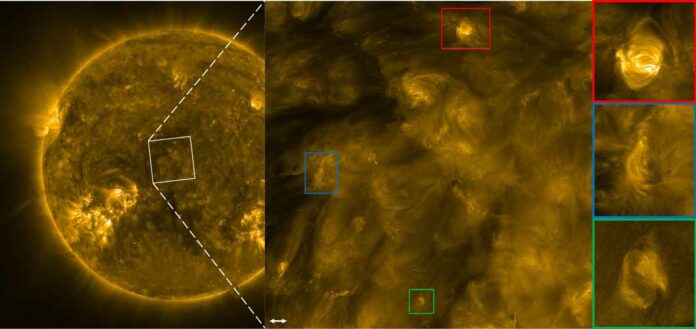In a groundbreaking discovery, a joint scientific team led by the Royal Observatory of Belgium (ROB) and the prestigious KU Leuven has unraveled one of the most captivating mysteries of our solar system.
The team’s research sheds new light on why the sun’s atmosphere, known as the corona, maintains a temperature millions of degrees hotter than its visible surface.
The Enigmatic Coronial Heating Problem
For decades, scientists grappled with the enigmatic coronal heating problem. According to the traditional understanding of temperature distribution, heat decreases as one moves away from the source.
However, the sun defies this logic, as its core is its sole heat source, while the corona, the outermost layer of its atmosphere, blazes with temperatures about 200 times hotter than the sun’s surface.
Magnetic Waves: The Key to Unlocking the Mystery
Professor Tom Van Doorsselaere of KU Leuven highlights that over the past 80 years, astrophysicists have diligently worked to decipher this puzzle.
Now, thanks to the joint scientific efforts, compelling evidence is emerging that high-frequency magnetic waves could be the missing piece to this cosmic riddle.
Unprecedented Observations by the EUI Telescope
The breakthrough findings were developed using observations from the Extreme Ultraviolet Imager (EUI) telescope, which is onboard the Solar Orbiter, a spacecraft operated by the European Space Agency (ESA).
The EUI, managed by ROB, has provided astronomers with images of the solar corona at an unprecedented resolution.
Heating the Solar Atmosphere
The EUI telescope’s observations have revealed the presence of fast oscillations within the smallest magnetic structures of the solar corona.
Astonishingly, these high-frequency waves play a crucial role in heating the sun’s atmosphere.
This discovery opens up exciting possibilities for understanding the mechanisms behind coronal heating.
Weighing the Energies
The scientists’ central question revolved around comparing the energy originating from the newly discovered fast oscillations with that of similar but slower oscillations that were already known.
To answer this, the scientific team conducted a meta-analysis, a statistical approach that amalgamates multiple scientific studies to extract common truths.
The Verdict: High-Frequency Waves Take the Lead
Dr. Daye Lim, the lead author of the study, conclusively stated that high-frequency waves contribute significantly more to the total heating of the corona than their low-frequency counterparts.
This revelation marks a crucial turning point in understanding the sun’s atmospheric behavior.
Towards New Discoveries
Dr. David Berghmans, the principal investigator of the EUI, expressed excitement over the results and emphasized their commitment to uncovering even higher-frequency magnetic waves with the EUI.
This ongoing research promises to deepen our comprehension of the sun’s enigmatic corona.
In conclusion, the joint efforts of the Royal Observatory of Belgium and KU Leuven have propelled our understanding of the sun’s atmosphere to new heights.
The role of high-frequency magnetic waves in maintaining the corona’s scorching temperatures has been unveiled, but many questions remain unanswered.
As scientists continue to explore the mysteries of our solar system, humanity draws ever closer to unlocking the secrets of the universe’s shining star – the sun.
FAQs
The Royal Observatory of Belgium (ROB) is a prestigious research institution dedicated to the study of astronomy, astrophysics, and geophysics. It plays a vital role in advancing our understanding of the universe and the Earth’s geophysical processes.
KU Leuven, short for Katholieke Universiteit Leuven, is one of Europe’s oldest and most renowned research universities located in Leuven, Belgium. In the context of this research, KU Leuven is leading the scientific team, and Professor Tom Van Doorsselaere is one of the key researchers working on the project.
The coronal heating problem refers to the puzzling phenomenon of the sun’s outermost layer, the corona, being significantly hotter than its visible surface, the photosphere. This contradicts the conventional understanding that temperatures decrease with distance from the heat source.
The scientific team made this groundbreaking discovery through observations from the Extreme Ultraviolet Imager (EUI) telescope onboard Solar Orbiter, a spacecraft operated by the European Space Agency (ESA). The EUI telescope, managed by ROB, captured images of the solar corona with unprecedented resolution, revealing fast oscillations in the smallest magnetic structures.
The findings published in The Astrophysical Journal Letters are of immense importance as they provide compelling evidence that high-frequency magnetic waves play a significant role in heating the sun’s corona. This discovery challenges existing theories and opens up new avenues of research to better understand the sun’s atmosphere.
The scientific team conducted a meta-analysis to compare the energy contributions of high-frequency waves with those of slower oscillations. The results indicated that high-frequency waves make a more substantial contribution to the overall heating of the corona than their slower counterparts.
The discovery of the role of high-frequency magnetic waves in coronal heating has far-reaching implications for future solar studies. It provides scientists with valuable insights into the mechanisms that govern the sun’s atmosphere and could lead to a better understanding of space weather, solar flares, and other solar phenomena.
More information: The Astrophysical Journal Letters (2023). DOI: 10.3847/2041-8213/ace423

